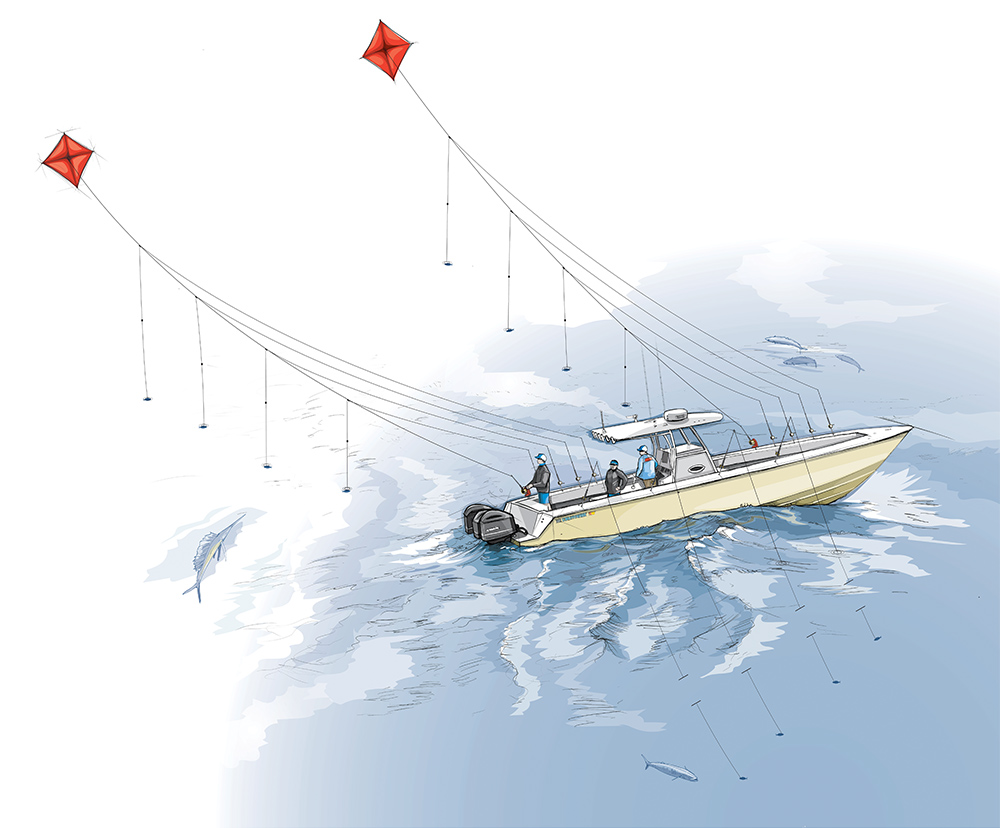
Kite Fishing Live Bait : Everything You Need to Know
Kite fishing is a highly effective technique for targeting a wide variety of fish species. It provides anglers with a distinct advantage by allowing the presentation of live baits in a versatile manner while keeping the terminal tackle above the water, preventing the targeted fish from detecting it. Similar to outriggers, a kite line can be equipped with multiple release clips to which fishing rods are attached. This setup enables anglers to offer various baits at different distances from the boat, catering to the preferences of the fish.
Depth of water is a critical consideration in kite fishing. Starting at a specific depth and utilizing the current, anglers can fine-tune their approach based on the fish’s behavior. It’s essential to observe strikes during the drift from point A, where fishing commenced, to point B, the final drift destination. By noting these strikes, anglers can focus on a narrower depth range between the two points. When the drift reaches a certain depth, it’s time to reel in and reset, ensuring a more productive time on the water.
Kite fishing isn’t limited to boat owners; it rewards those who are innovative and daring. Originally developed and refined for catching species like Mahi, Sailfish, Wahoo, Kingfish, and Tuna off the Southeastern coast of Florida, this technique has gained popularity among anglers worldwide. Even those pursuing Giant Bluefin Tuna in California have found success by adopting kite fishing into their strategies.”
Bait of Choise : Live thread-fin-herring, goggle-eye, pilchards, sardines, cigar minows, blue-runners, ballyhoo
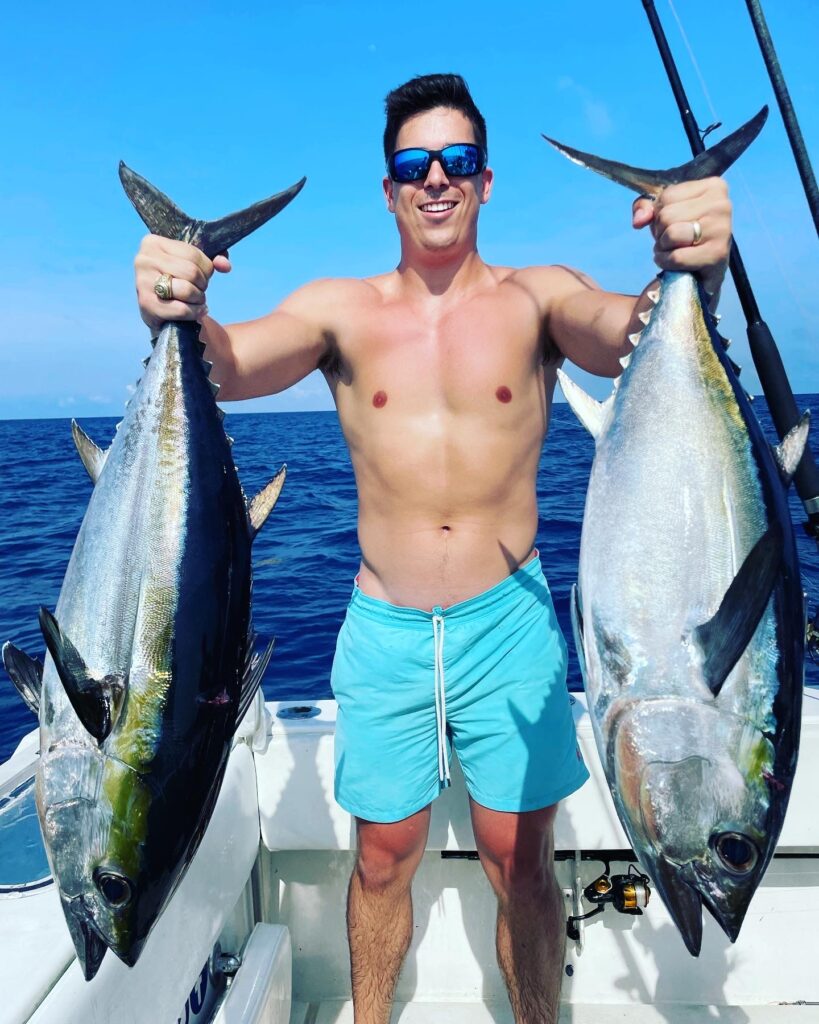
Tuna fishing live chumming and chunking
Tuna fish are renowned for their rapid growth and extensive migrations, requiring a substantial food supply for their development. Our approach begins with identifying and intercepting the migratory path of tuna schools, utilizing radar to locate the flocks of birds that trail these fish. Our chumming technique involves generously dispersing unhooked bait, such as live pilchard or sardine chunks, into the water. This method establishes us as the primary food source, enticing the tuna to feed around our boat and sparking a feeding frenzy.
Miami offers opportunities to catch Blackfin Tuna, with the possibility of landing a prized, large Yellowfin Tuna weighing up to 150 pounds, a true trophy catch. Additionally, the Bahamas, a mere 90-minute journey away, presents opportunities to target Yellowfin Tuna and Blackfin Tuna of various sizes.”
Year Round
Bait of Choise : Pilchards, sardines, cigar-minows
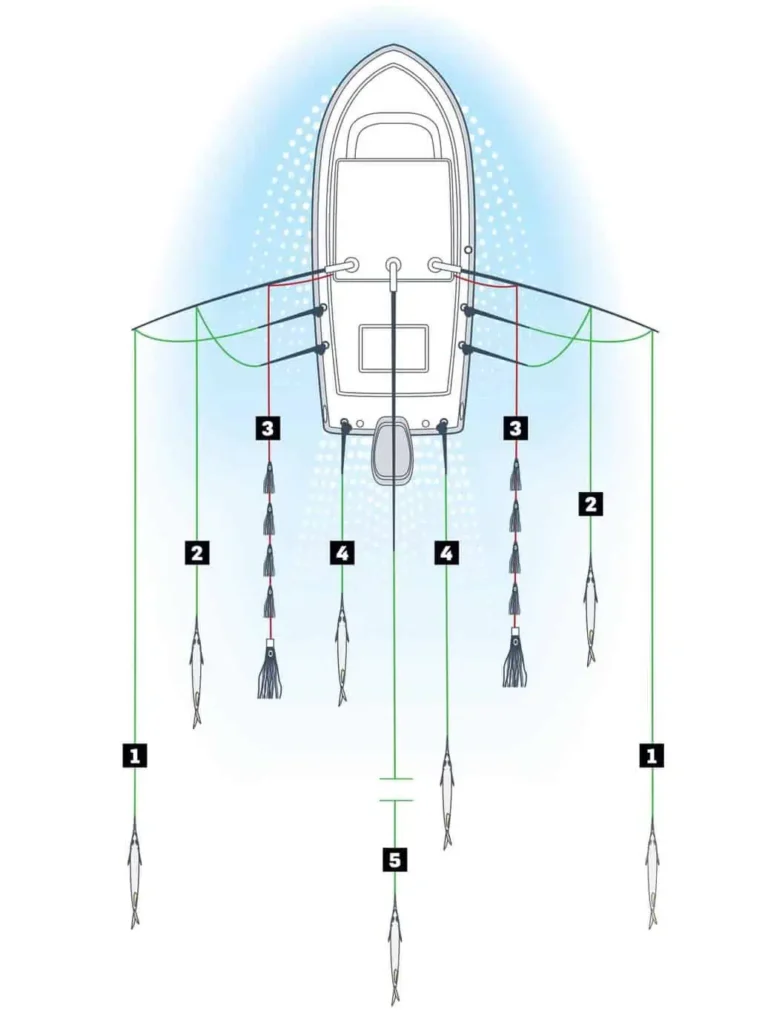
Trolling dead and artificial Bait
Trolling is a fundamental fishing technique employed by anglers to efficiently cover a significant area by trailing baits or lures behind a moving boat at speeds typically ranging from 5 to 8 knots, utilizing the boat’s engine to impart lifelike movement to the baits. It’s an effective method for targeting a variety of species such as Mahi-Mahi, small Tuna, and Marlin in this region, especially along the extensive stretches of floating weed lines that form offshore, often harboring schools of fish.
A standard trolling setup includes a spread of 4 to 6 fishing rods in the 30-pound class, complemented by two teaser squid chains attached to outriggers. These teasers create the illusion of a school of fish in a fleeing motion behind the boat, enticing predatory species. In some instances, when the sargassum weed is particularly dense and scattered, we may be limited to trolling only 2 artificial baits. During such times, our well-trained eyes become invaluable in locating feeding fish amidst the challenging conditions.
June – October are the best months for trolling.
Bait of choice : Ballyhoo lure combo, naked ballyhoo, mold craft lures, Peter Pakula lures, Tuna feathers.
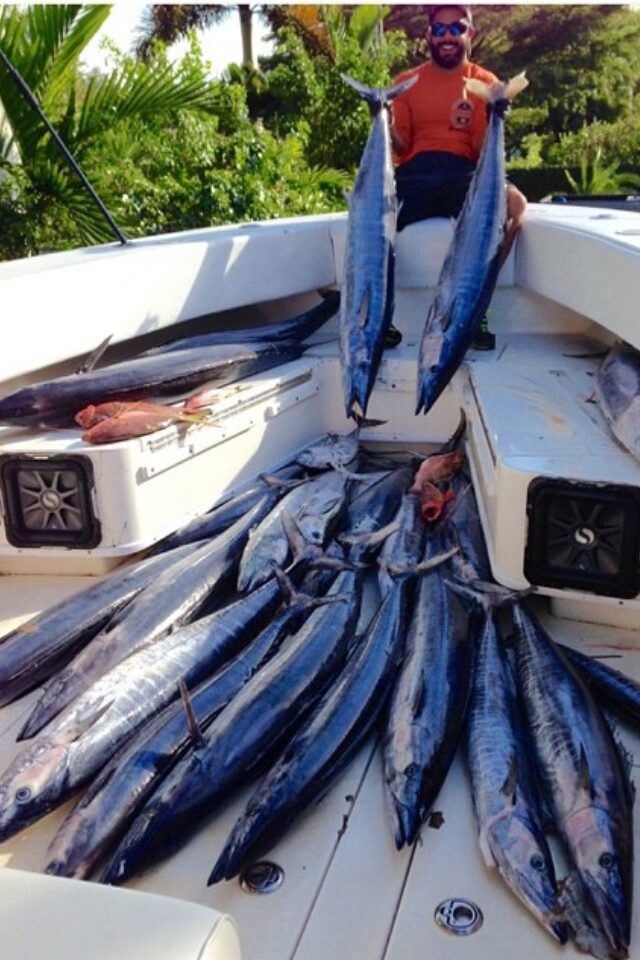
High Speed Wahoo Trolling
High-speed trolling is a specialized fishing technique that involves pulling artificial lures through the water at significantly higher speeds compared to conventional trolling methods. This approach was developed with a dual purpose in mind: to cover a large area efficiently and to specifically target Wahoo while minimizing the risk of by-catch from species like barracuda and mackerel.
To achieve the optimal speeds of 14 to 16 knots required for high-speed trolling, the use of a 1 to 2-pound weight is essential to prevent the bullet-shaped lures from skipping on the water’s surface. In this method, we employ a 4 to 6-line rod spread, using robust 80-pound class tackle to withstand the considerable stress exerted on the equipment while trolling in the 100 to 600-foot depth range.
September- March are the best months to target Wahoo.
Bait of choice : Islander high speed lures, Bonito strips
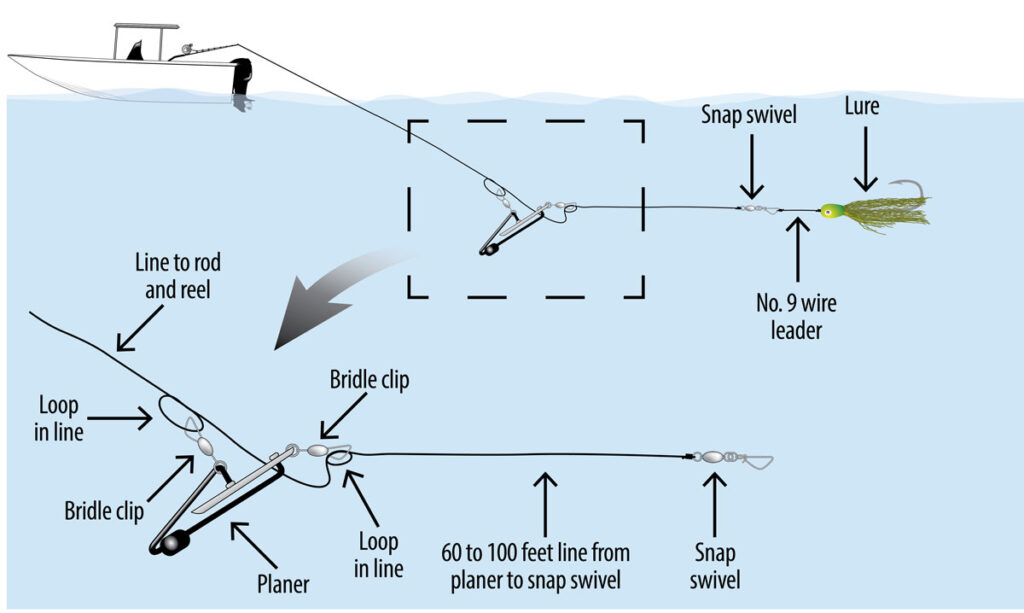
Planer Fishing
Planers are compact, square-shaped devices employed during trolling to vary the depth at which baited lines are presented in the water column. They achieve this by harnessing the water’s force to angle themselves downwards, carrying the baited line along with them. Our technique involves attaching the planers approximately 75 feet ahead of the bait on the main line before deploying them to their desired depth, ranging from 20 to 80 feet deep behind the boat.
Once a fish takes the bait and becomes hooked, it exerts pressure on the 75-foot leader connected to the rear of the planer. This action causes the planer to trip, returning it to the surface for the angler to reel in the fish. To execute this approach effectively, we utilize Penn International 30’s conventional reels spooled with 80-pound braid, which not only facilitates the line’s easy slicing through the water but also handles the substantial strain that the tackle experiences during the process.
Year Round
Bait of choice : Bonito strip bait, rigged ballyhoo, 3 1/2 drone spoon,
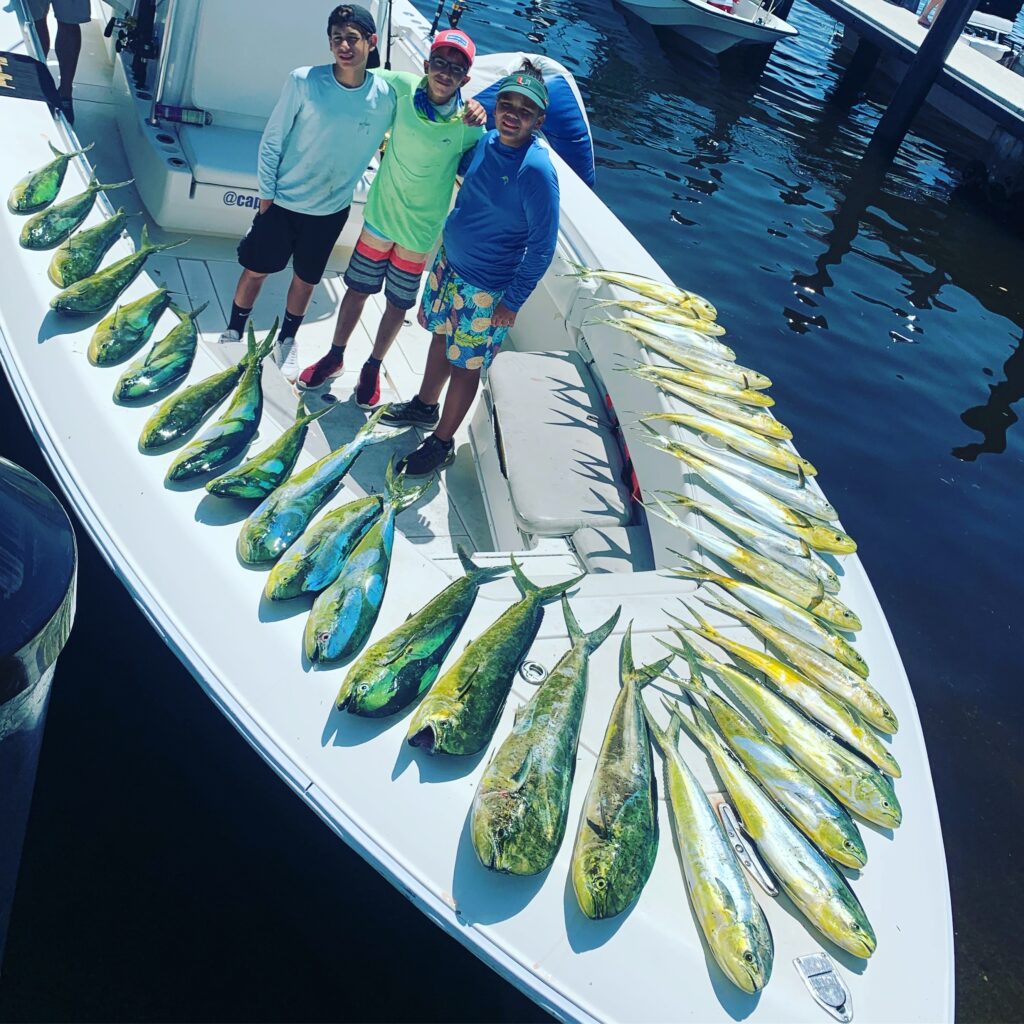
Run and Gun Dolphin fishing
Run and Gun Fishing involves running the boat at a brisk cruising speed without any fishing lines in the water. This technique allows us to cover a substantial amount of ground and consume fuel quickly. During this process, our radar system and keen eyes are actively scanning for signs of marine life such as birds, floating debris, or other indicators in the vast open ocean, often many miles offshore.
The objective of Run and Gun Fishing is to locate promising spots and swiftly approach them to pitch live or dead baits. This approach is particularly effective during the summer months when we are targeting Mahi-Mahi, especially in tournament settings. It provides us with a strategic advantage by reaching less-fished waters ahead of other anglers, including weekend warriors, who may be targeting the same species.
June – November during calm days
Bait of choice : Pilchards and small jacks
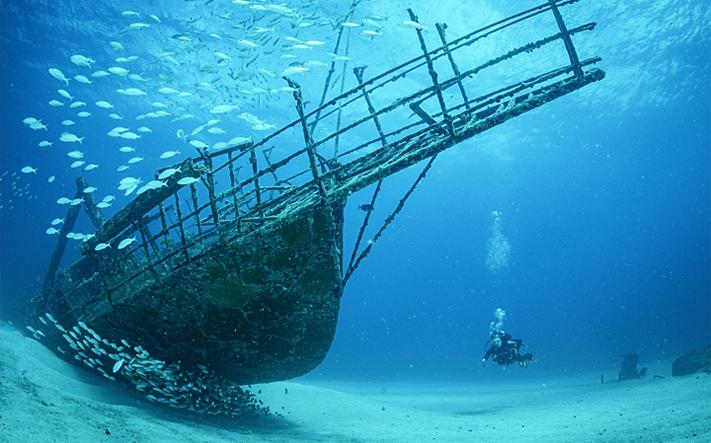
Ship Wreck Reef fishing
Miami Dade County boasts a vast collection of intentionally sunken large shipwrecks and artificial reefs, strategically positioned to enhance the sport fishing experience by attracting both bait and game fish. These submerged structures are distributed across depths ranging from 50 to 400 feet, and many of them are clustered together in a region known as the county wrecks.
These shipwrecks serve as powerful magnets for a diverse range of species, including grouper, African pompano, amberjack, large snappers, wahoo, kingfish, barracuda, sharks, and numerous others that inhabit these waters. When targeting these wrecks, we employ a specialized approach. We use a bottom rod equipped with 80-pound braided line, which is essential to handle the substantial pressure required to lift these formidable fish out of the wreck.
In addition to the bottom rod, we utilize a lighter 20-pound outfit positioned in the mid-water column to target fish swimming above the wreck. This mid-level strategy is effective for species such as kingfish, wahoo, tuna, Sailfish, and more. Furthermore, a third 20-pound outfit is deployed on the surface, ensuring full water column coverage for an optimal fishing experience.
Year round
Bait of choice : Pinfish, Grunts, Jacks, Pilchards, Ballyhoo
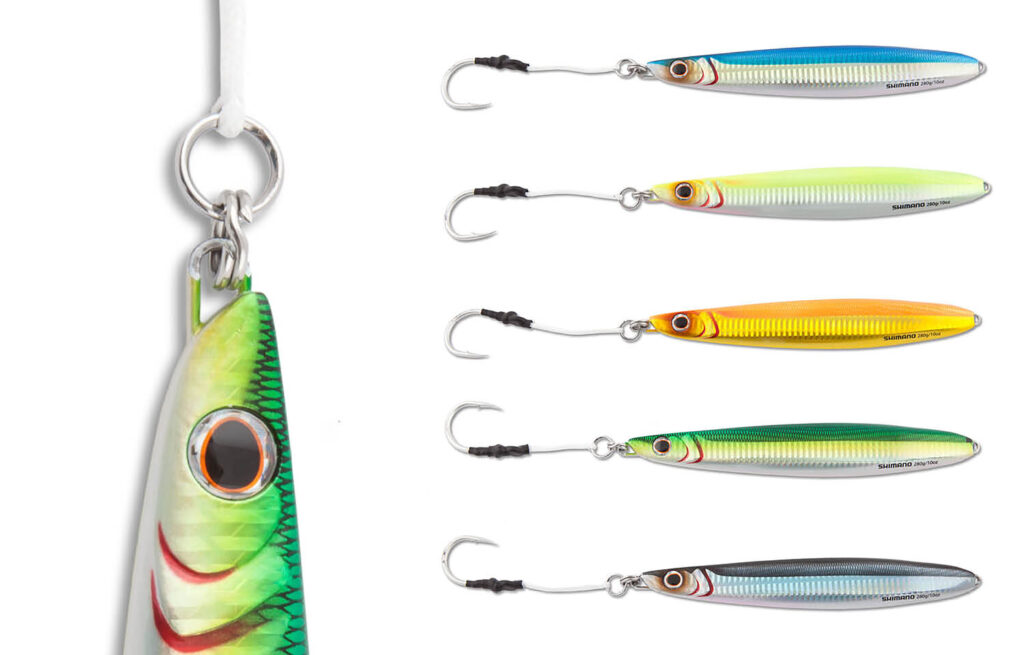
Deep Reef Vertical Jigging
Vertical jigging is a sophisticated angling technique that involves lowering an artificial, painted lead lure down to significant depths and subsequently retrieving it either rapidly or slowly to provoke a reaction strike from aggressive fish. The key to success in vertical jigging is maintaining continuous movement, imitating the actions of a real baitfish attempting to evade predators.
Among the species frequently targeted through vertical jigging, Amberjack, Barracuda, and Tuna are the most commonly caught. These fish are known for their deep-swimming habits and aggressive behavior. On our charters, we are well-equipped for vertical jigging with two Penn Spinfisher 6500 VI spinning reels spooled with 50-pound braid and fluorocarbon leaders, complemented by a diverse array of 80-200-gram jigs.
Vertical jigging is typically employed near sunken shipwrecks, reefs, and within Tuna schools, where depths can range from 100 to 600 feet. This method is renowned for its ability to entice strikes from powerful and formidable ocean predators.
Year round
Bait of choice : Artificial Jigs (no bait)
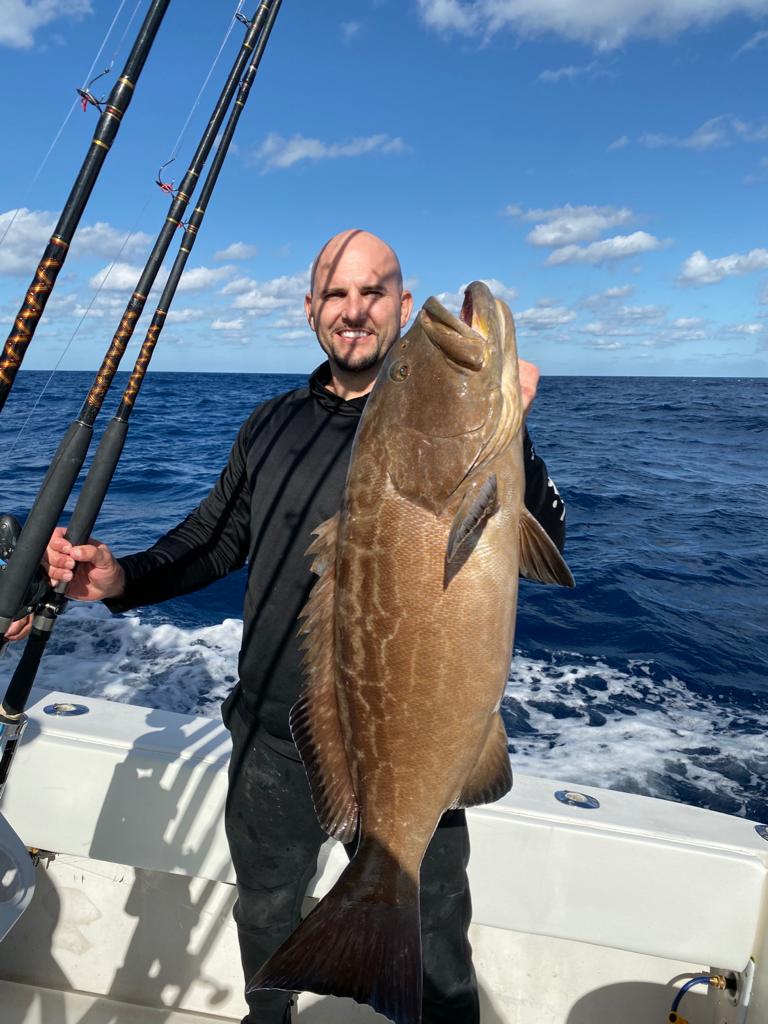
Bottom fishing
Florida’s Coral Reef is a natural wonder, boasting the title of the largest coral reef ecosystem in the continental United States. This expansive system of shallow coral reefs stretches across an impressive 358-mile expanse. The region between 30 and 90 feet of depth represents a significant transition zone, holding a rich diversity of marine life.
Within this captivating underwater world, you can expect to encounter species such as Yellowtail and Mutton Snapper, Grouper, Mackerel, and a variety of other marine inhabitants. Fishing in this style typically begins with locating an area with gentle current conditions along a well-known reef system. The next step is anchoring the vessel up current from the desired fishing spot.
Once anchored, an essential technique involves chumming the water. This is achieved by dispersing generous amounts of chum, usually consisting of a mixture of oats and chum, into the water. The goal is to create a chum slick that attracts a multitude of fish to the area.
During this type of fishing, two 16-pound outfit rods are employed for free-lining baited hooks back into the chum slick. These rods primarily target species like snappers that are attracted to the chum. Additionally, a heavier bottom rod outfit is used to target larger bottom-dwelling fish, including Grouper and other bottom species.
Fishing over Florida’s Coral Reef offers a rewarding and immersive experience, allowing anglers to connect with the diverse marine life thriving within this remarkable underwater ecosystem.
Year Round
Bait of choice : pilchards, silver sides, ballyhoo, pinfish, oats, tournament chum
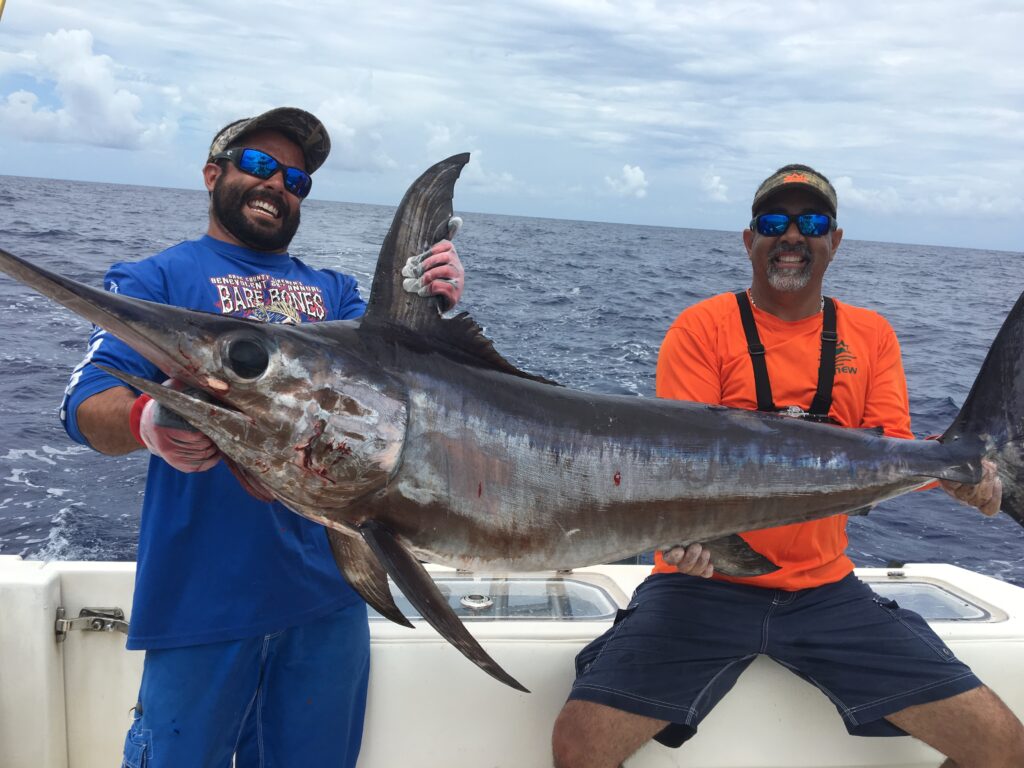
Day Time Swordfish
Daytime swordfishing is an intriguing pursuit that takes anglers to the depths of the sea, where these elusive creatures roam. Swordfish are known to retreat to the depths during the day, typically resting in the abyssal zone, which lies between 1400 and 1900 feet deep. In this dark, mysterious environment, they forage for a variety of prey, including squids, crustaceans, and deep-sea fish with otherworldly appearances.
Fishing for swordfish during daylight hours is no small feat and requires specialized equipment. Large electric assist reels play a crucial role in aiding anglers in the retrieval process, especially considering the use of hefty 8-12 pound lead weights. These substantial weights are essential to anchor the bait and tackle in place due to the rapid and powerful currents of the Gulf Stream.
A key aspect of daytime swordfishing is the utilization of a complex two-rod spread. The first is the tip rod, which is positioned right off the side of the boat and is designed to touch the seabed regularly. This rod provides a unique opportunity to target swordfish that may be lurking close to the bottom.
The second rod, known as the buoy rod, is deployed differently. It is lowered to a depth ranging from 200 to 500 feet above the seafloor to avoid potential snags. Once it reaches its desired depth, a buoy float is attached to the main line, and this float is set approximately 300 feet behind the boat. This setup allows for coverage at varying depths, increasing the chances of attracting swordfish.
While engaged in daytime swordfishing, there’s also the opportunity to set a live bait on a spinner, which can entice curious Mahi-Mahi swimming near the boat. This adds an exciting element to the fishing experience and keeps anglers engaged throughout the process.
Year round
Bait of choice : Rigged Bonito belly, Squid, Mahi belly
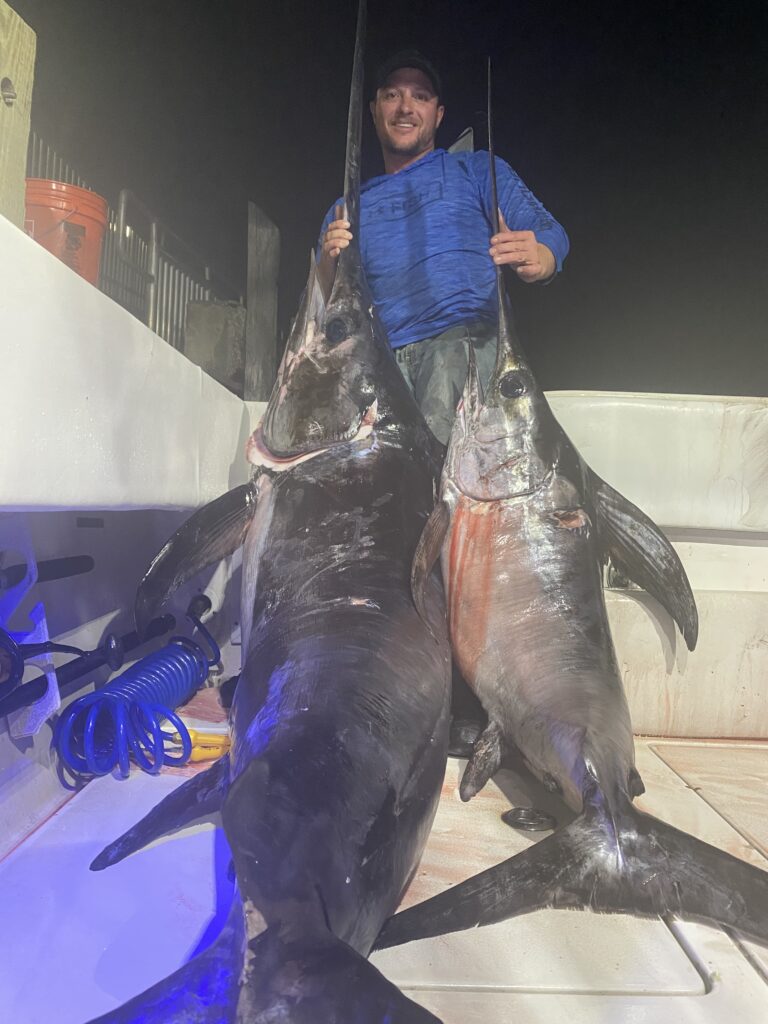
Night Time Sword Fishing
Swordfish are renowned for their prowess in hunting during low light conditions. They possess large eyes that are well-suited for navigating the pitch-black darkness of the ocean depths. As the sun sets, these remarkable creatures begin their ascent from the profound depths of around 1800 feet to the upper 500 feet. This ascent follows the daily vertical mass migration of baitfish, which provides them with a prime opportunity for hunting.
During this twilight zone, anglers can deploy a six-rod spread, each equipped with robust Penn International reels, typically in sizes 50 and 80 wides. These reels are spooled with 80-pound braid-monofilament combinations, ensuring they are capable of handling the immense power of a swordfish. To attract these formidable creatures, baits such as rigged squid, bonita belly, and live jacks are commonly used. These baits are often adorned with lights attached to the leader, creating an enticing spectacle to lure in curious sea life.
Waiting for a bite under the starlit night sky while sharing stories and camaraderie with fellow anglers is an incredible experience. This tranquil setting is only disrupted by the electrifying sound of a reel screaming as a swordfish is hooked, marking the beginning of an exhilarating battle between angler and fish. This timeless pursuit offers a unique and unforgettable connection with the sea and its enigmatic inhabitants.
Year round
Bait of Choise : Squid, Boston Mackerel, Live Jacks, Bonito belly
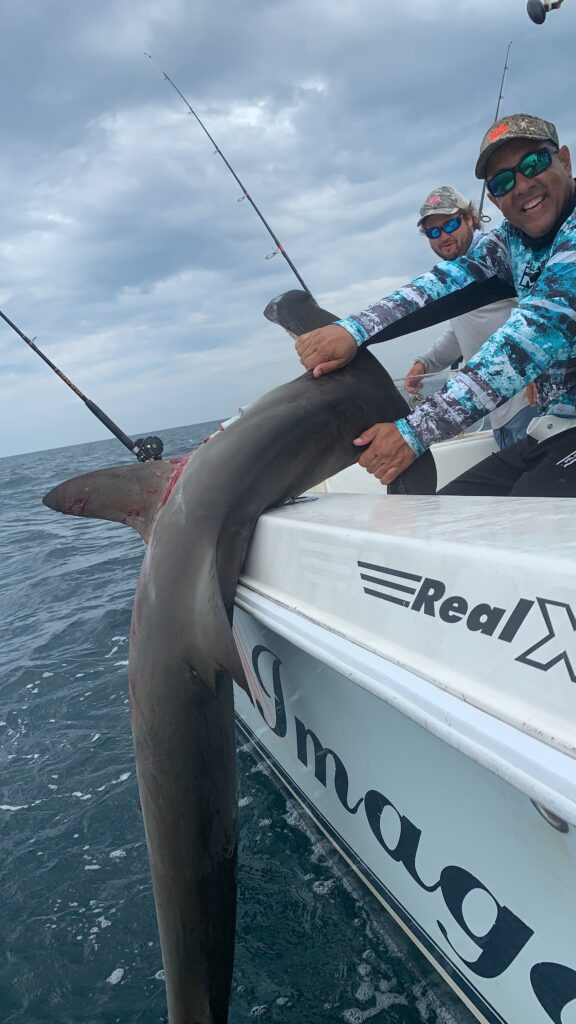
Shark fishing
Sharks are a prevalent presence in the Miami fishing scene, thanks to South Florida’s thriving marine ecosystem. Offshore shark fishing is conducted using robust bent butt Penn rods paired with powerful Penn 50 International VISW reels, which are spooled with heavy-duty 80-pound monofilament line. For bait, bonito is commonly used and is affixed to large hooks with sturdy wire leaders designed to withstand the formidable teeth of sharks.
A variety of shark species, including Bull Sharks, Dusky Sharks, Tiger Sharks, and Hammerhead Sharks, can be encountered while offshore shark fishing. These predators often frequent areas near shipwrecks or locations teeming with marine life in water depths ranging from 100 to 500 feet. The thrill of tangling with these apex predators is a memorable experience, and it’s accessible to anglers of various skill levels.
Sharks also inhabit the tranquil inshore waters, where they can be found near beaches, mangroves, and marinas in shallower depths of around 10 feet. This makes inshore shark fishing easily accessible and enjoyable for both novice and experienced anglers alike. The opportunity to engage with these incredible creatures adds an exciting dimension to the diverse fishing opportunities in the Miami area.
Year round
Bait of choice : Bonito and Mackerel
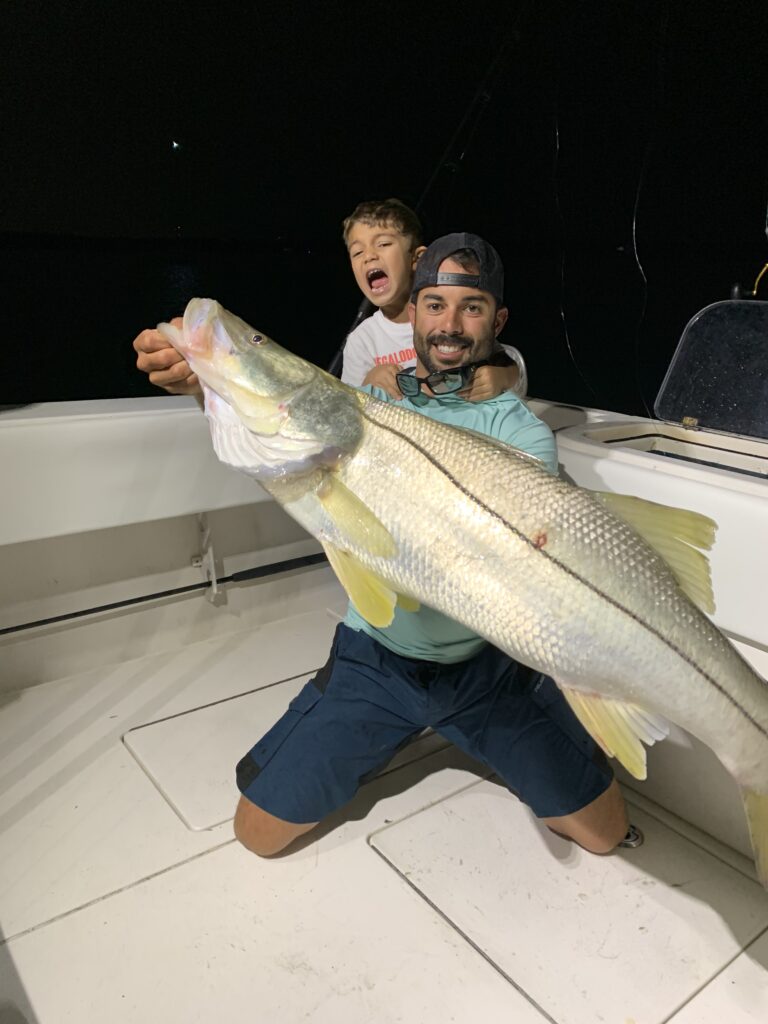
Tarpon & snook inshore fishing
Tarpon and Snook are known as ambush predators that strategically position themselves behind structures near bridges and inlets, where they wait for the opportunity to feed on baitfish swept in by the fast tidal currents. When targeting Tarpon, the approach involves locating a school of these majestic fish and deploying a three-line spread that is either drifted ahead of their migratory path or slow-trolled using live baits. This method aims to entice Tarpon to strike, offering anglers an exhilarating fight with these powerful and acrobatic fish.
For Snook and Tarpon that are staged near bridges or other underwater structures, a different technique is employed. Anglers power drift or anchor near these locations and use baited lines that are allowed to float back naturally in the current. This method takes advantage of the natural flow of the tide, increasing the chances of enticing these predatory fish to strike. It requires skill and finesse to hook and land Snook and Tarpon in these challenging environments, but the reward is the opportunity to catch these prized game fish that are known for their strength and resilience.
Snook : Year Round
Tarpon : Year Round
Bait of choice : Shrimp, Crab, Croakers, Mullet
